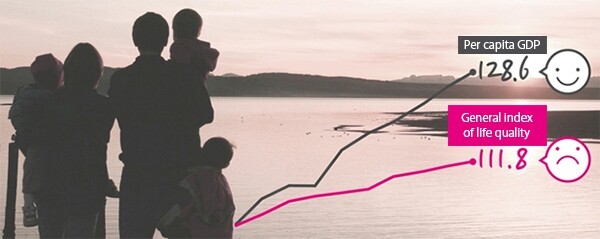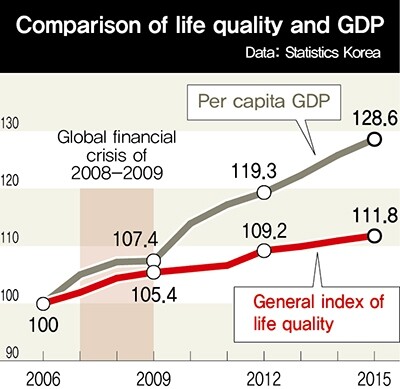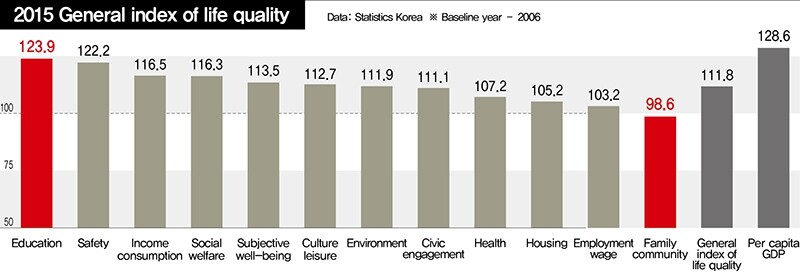hankyoreh
Links to other country sites 다른 나라 사이트 링크
South Korea’s GDP has risen, but quality of life hasn’t kept pace

The first-ever statistics representing South Korean quality of life in numerical terms were released on Mar. 15.
While South Korea’s economic wealth in terms of gross domestic product (GDP) has grown by 28.6% since 2006, the increase in the general index of life quality was just 11.8% - a figure that raises questions about possible reconsideration of what economic development is supposed to achieve.
Released on Mar. 15 by Statistics Korea, the general index of life quality for South Korea stood at 111.8 for 2015, or 11.8 percentage points higher than the baseline year of 2006, which was scored at 100.

The rise was less than half the 28.6% increase in per capita GDP over the same period.
“Even amid the ongoing economic growth of the ’00s, there was a perception that subjective well-being was not keeping pace, resulting in continued calls here and overseas to stop focusing so much on quantitative growth,” explained Choi Ba-wool, head of the Statistical Research Institute’s policy indicator research division.
“That’s what led to the development of indicators focused on South Koreans and South Korean society,” Choi said.
The general index of life quality for South Koreans is an aggregate of 80 indicators in 12 areas, including education, safety, income/consumption, civic engagement, housing, employment/wage, and family/community. Since 2009, Statistics Korea has been working with the Korean Quality of Life Society to research an index to address the limitations of GDP-centered quantitative economic metrics by measuring the level of qualitative social development.
Life quality improvements were found to be slowest in the areas of family/community, employment/wage, and housing. At 103.2, the total for the employment/pay quality of life index was well short of the 111.8 general index. The housing index came in at 105.2, while health rated 107.2. The family/community quality of life index was 98.6, showing a 1.4% decline from 2005 levels. Areas that saw rapid improvement in quality of life in the last 10 years included education (123.9) and safety (122.2).
“South Korea is a country where family and community used to have a large role in caregiving and welfare, but family ties have rapidly degraded amid the recent stagnation in the economic growth rate,” explained Seoul National University sociology professor Kim Seo-ho, who took part in developing the index.
Kim added that the findings “suggest we should be making a policy priority of areas where the rise in the quality of life index has failed to keep up with the average, including family/community, employment/pay, and housing.”

But the question of how true to life the index is appears likely to be the subject of ongoing debate. The recent popularity of the term “Hell Joseon” shows that perceived quality of life is already rock-bottom for many South Koreans. Questions about the rises in several quality of life indicators appear inevitable.
“The general index was arrived at through a mixture of objective and subjective indicators,” explained Kim. “It looks there will need to be some ongoing efforts to improve perceived satisfaction with the general index, including the assignment of weighted values to subjective indicators,” he added.
By Kim Kyung-rok and Noh Hyun-woong, staff reporters
Please direct questions or comments to [english@hani.co.kr]

Editorial・opinion
![[Column] Park Geun-hye déjà vu in Yoon Suk-yeol [Column] Park Geun-hye déjà vu in Yoon Suk-yeol](https://flexible.img.hani.co.kr/flexible/normal/500/300/imgdb/original/2024/0424/651713945113788.jpg) [Column] Park Geun-hye déjà vu in Yoon Suk-yeol
[Column] Park Geun-hye déjà vu in Yoon Suk-yeol![[Editorial] New weight of N. Korea’s nuclear threats makes dialogue all the more urgent [Editorial] New weight of N. Korea’s nuclear threats makes dialogue all the more urgent](https://flexible.img.hani.co.kr/flexible/normal/500/300/imgdb/original/2024/0424/7317139454662664.jpg) [Editorial] New weight of N. Korea’s nuclear threats makes dialogue all the more urgent
[Editorial] New weight of N. Korea’s nuclear threats makes dialogue all the more urgent- [Guest essay] The real reason Korea’s new right wants to dub Rhee a founding father
- [Column] ‘Choson’: Is it time we start referring to N. Korea in its own terms?
- [Editorial] Japan’s rewriting of history with Korea has gone too far
- [Column] The president’s questionable capacity for dialogue
- [Column] Are chaebol firms just pizza pies for families to divvy up as they please?
- [Column] Has Korea, too, crossed the Rubicon on China?
- [Correspondent’s column] In Japan’s alliance with US, echoes of its past alliances with UK
- [Editorial] Does Yoon think the Korean public is wrong?
Most viewed articles
- 1‘We must say no’: Seoul defense chief on Korean, USFK involvement in hypothetical Taiwan crisis
- 2N. Korean delegation’s trip to Iran shows how Pyongyang is leveraging ties with Moscow
- 3Amnesty notes ‘erosion’ of freedom of expression in Korea in annual human rights report
- 4[Column] Park Geun-hye déjà vu in Yoon Suk-yeol
- 5‘Weddingflation’ breaks the bank for Korean couples-to-be
- 6[Reportage] On US campuses, student risk arrest as they call for divestment from Israel
- 7[Editorial] New weight of N. Korea’s nuclear threats makes dialogue all the more urgent
- 8Why Korea shouldn’t welcome Japan’s newly beefed up defense cooperation with US
- 9[Guest essay] The real reason Korea’s new right wants to dub Rhee a founding father
- 10Will NewJeans end up collateral damage in internal feud at K-pop juggernaut Hybe?